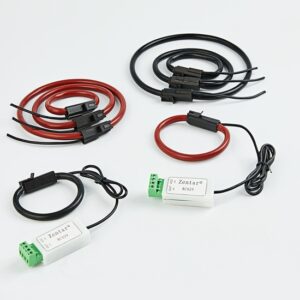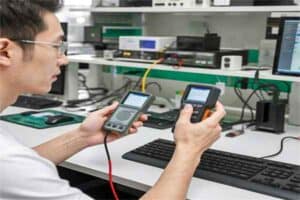If you’re dealing with high-voltage and high-current AC circuits, you’re walking into a world where direct measurement just isn’t safe—or practical. To bridge this gap, voltage transformers (VTs) and current transformers (CTs) step in as essential tools. They don’t just reduce the voltage and current to safer levels—they preserve the accuracy needed for precise energy measurement, system control, and protection.
Let’s break down how they work, why they’re crucial, and how to use them effectively without frying your system (or yourself).
Basics of Electrical Measurement in Power Systems
Trying to measure thousands of volts or amps directly? That’s asking for trouble. Instruments would need massive insulation, and safety risks would skyrocket.
Transformers solve this by scaling down those values proportionally. Then, standard meters or relays can safely read what’s going on. It’s like translating a loud stadium concert into a clean audio file—same content, manageable volume.
What is a Voltage Transformer?
Core Concept and Purpose
A voltage transformer, or VT, is designed to accurately reduce high voltage to a standard value, typically 100V or 110V. This is vital for voltage monitoring, metering, and protection.
Key Structural Features
-
Primary winding: Many turns, connected directly to the high-voltage line.
-
Secondary winding: Fewer turns, feeding a meter or relay with low voltage.
-
Magnetic core: Optimized to minimize loss and distortion.
How Voltage Transformers Operate
They’re built to work at or near full load, which means their voltage drop remains very consistent.
Primary vs Secondary Winding Setup
The primary winding takes on the full brunt of the high voltage. The secondary winding is isolated but proportionally replicates the voltage for measurement purposes.
Load Characteristics and Stability
VTs usually drive high impedance loads like voltmeters or protective relays, which means the current is minimal and stable—reducing the chances of overload.
What is a Current Transformer?
Principle and Function
A current transformer (CT) is the opposite: it scales down large currents to a standard 5A or 1A, making it possible to safely monitor load current.
Structural Differences from Voltage Transformers
-
Primary winding: Often just one or a few turns, connected in series with the load.
-
Secondary winding: More turns, delivering a scaled-down current to instruments.
Serial Connection in the Power Circuit
Unlike VTs, CTs are always connected in series, so all load current flows through them.
Low Impedance Operation
CTs typically connect to low impedance meters, keeping them close to a short-circuit condition under normal operation.
Short-Circuit-like Behavior Under Normal Conditions
This condition ensures that CTs remain accurate and do not develop dangerously high voltages, as long as the secondary is never opened.
The Working Principles Explained
Magnetic Flux and Load Interaction
In both VTs and CTs, the magnetic flux inside the core is the bridge between input and output. However, the behavior differs:
-
VTs maintain stable voltage regardless of minor load changes.
-
CTs are sensitive to impedance changes in the secondary circuit.
The Role of Excitation Current
If the secondary of a CT is open, the entire primary current becomes excitation current, driving the core into saturation—and potentially causing a breakdown.
Effect of Load Impedance on Output
In VTs: higher load impedance → negligible change.
In CTs: higher impedance → lower secondary current → higher core excitation → inaccurate results.
Key Differences Between Voltage and Current Transformers
Operation Under Load
-
VTs: Stable under high impedance
-
CTs: Stable under low impedance
Primary-Secondary Current Relationship
-
VTs: Ratio based on turns, voltage-driven
-
CTs: Ratio based on turns, current-driven
Risks and Safety Considerations
-
Open CT secondary = Danger Zone
-
Overloaded VT secondary = Slight drop in accuracy
Importance in Power System Applications
Measurement and Monitoring
Meters and sensors rely on CTs and VTs to safely measure line values.
Relay Protection Systems
They feed accurate values into protection relays, triggering circuit breakers during faults.
Signal Labeling and Energy Metering
They also help tag real-time data in smart grids, enabling demand-response systems.
Real-World Example: High-Voltage Power Supply Systems
In a 220kV grid, you can’t just hook up a voltmeter. A VT brings that voltage down to 110V, letting you monitor it precisely. Similarly, CTs let you track current up to 2000A by converting it to 5A.
Best Practices in Using Voltage and Current Transformers
Ensuring Accuracy and Safety
Always match the transformer’s rating with the circuit specs. Underrated transformers are not just inaccurate—they’re dangerous.
Avoiding Overload and Saturation Issues
Don’t overload a VT. Don’t open a CT secondary. These are non-negotiables.
Proper Configuration with Instruments
Ensure secondary circuits are properly terminated with the correct burden.
Common Mistakes and How to Avoid Them
Secondary Circuit Open in CTs
This can induce dangerously high voltages. Always short-circuit the CT secondary during maintenance.
Improper Load Connection in VTs
Using too low an impedance on a VT? You’ll ruin the accuracy and possibly overheat the transformer.
Innovations in Transformer Design
Miniaturization and Efficiency
Modern VTs and CTs are getting smaller and smarter, thanks to new materials and winding techniques.
Integration with Smart Grids and IoT
Digital CTs/VTs with built-in communication modules are transforming how we monitor power systems.
Maintenance and Testing of VTs and CTs
Periodic Calibration
Check ratios and performance annually for precision.
Inspection for Core Saturation or Damage
Visual and thermal scans can help spot issues before failure.
Selecting the Right Transformer for Your System
Voltage Levels and Current Ratings
Match with system specs. Always factor in fault levels and future upgrades.
Load Compatibility and Accuracy Class
Choose the right accuracy class (e.g., 0.2, 0.5, 1.0) based on your application needs.
FAQs
1. What happens if the CT secondary is open?
It can induce high voltage, saturate the core, and even destroy insulation. Always keep the secondary closed or shorted during operation.
2. Can voltage transformers be used as power transformers?
No. VTs are designed for precision and light load, not for transferring power between voltage levels.
3. How do you determine the accuracy of a VT or CT?
Look at the accuracy class, typically labeled (e.g., 0.2, 0.5). Lower numbers mean higher accuracy.
4. Why is CT operated in a short-circuit-like condition?
To ensure minimal voltage drop and accurate current reflection from primary to secondary.
5. Are there digital alternatives to traditional VTs and CTs?
Yes, digital or optical transformers are emerging in smart grids for enhanced accuracy and communication.




